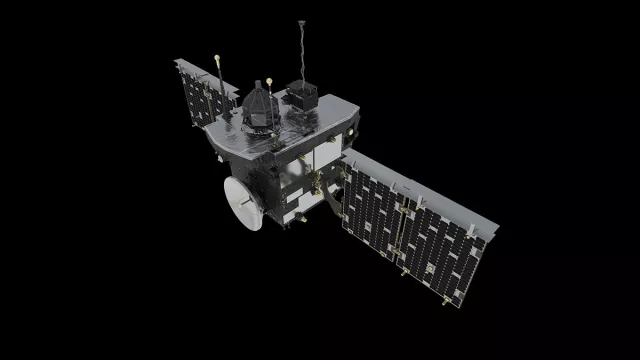Comprising three spacecraft, Comet Interceptor will be the first mission to visit a comet or interstellar object as it journeys into the inner solar system.
These spacecraft will perform simultaneous observations from multiple points around the target object, creating a 3D profile of a 'dynamically new' object containing surviving material untouched by the Sun.
Key information
| Mission | First encounter with a primitive comet or interstellar object approaching the Sun |
|---|---|
| Domain | Science |
| Start date | Mission adopted by ESA 8 June 2022, launch scheduled in 2029 |
| Partners | ESA, JAXA |
| Where | Stationed at L2 Lagrange point in readiness to intercept target object yet to be discovered |
| Lifetime | 4 years at L2 + 2-year cruise and then flyby lasting several weeks |
| Status | In development |
Key figures
- 3 spacecraft to intercept and track comet
- < 10 years in development (F-class ‘fast’ mission)
- ~600 kg: spacecraft mass
- 16 nations contributing
Key milestones
- 2029: Mission launch riding with ARIEL on Ariane 6
- August 2022: Go-ahead from CNES for phases B, C, D and E1
- 8 June 2022: Mission adopted by ESA Science Programme Committee (SPC)
- June 2019: Comet Interceptor selected by ESA
- July 2018: ESA call for F-class opportunity missions
Project in brief
Comets are ancient relics of the primitive solar system. While several have been studied up close before, all had already been radically altered by numerous previous encounters with the Sun. However, new comets that have never visited the inner solar system before continue to arrive from the Oort cloud, probably close to their original state and rich in volatile substances agglomerated at low temperature when they formed.
Similar objects outside the solar system also enter it from interstellar space. They have been ejected from the system where they first formed, offering the opportunity to study primordial matter that took shape around other stars.
Given the timescales involved in planning and launching space missions, it would have been very difficult to envision a mission to encounter such objects only shortly after their discovery. As a result, the scientific community hit on the idea of Comet Interceptor, which is special because its exact destination will not yet be known when it launches.
Comet Interceptor consists of three spacecraft: a primary satellite and two nanosatellites attached to it. They will travel together as a single unit to the L2 Lagrange point 1.5 million kilometres from Earth, where they will await an appropriate target object. After journeying to the selected target, the two nanosatellites will separate from the primary satellite a few hours before performing a flyby of the comet.
Each satellite will be carrying a suite of complementary scientific instruments to characterize the comet’s nucleus and gas, dust and plasma environment. Such multi-point measurements will greatly enhance the 3D data needed to understand the dynamic nature of a pristine comet while it is interacting with the constantly changing solar wind environment.
CNES’s role
CNES is working on the development of the primary satellite’s scientific instruments and on those of the European nanosatellite, and is contributing to the mission’s science operations centre. The other nanosatellite is being supplied by the Japan Aerospace Exploration Agency (JAXA).
CNES is overseeing the French research laboratories working on this mission. It has responsibility for final delivery of the French scientific instruments to the European Space Agency (ESA).
The French laboratories working on these instruments are:
IRAP and LAB, on LEES
LPC2E, on COMPLIMENT
LAM, contributing to CoCa
IRAP, contributing to Maniac
Contacts
Project Leader
Karine Mercier
E-mail: karine.mercier at cnes.fr
Sun, Heliosphere and Magnetospheres (SHM) subject matter expert
Kader Amsif
E-mail: kader.amsif at cnes.fr


